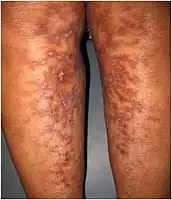Erythema ab igne
| Erythema ab igne | |
|---|---|
| Other names: Hot water bottle rash, fire stains, laptop thigh[1] | |
 | |
| Erythema ab igne in a person with chronic abdominal pain who found some relief from the application of heat. | |
| Specialty | Dermatology |
| Symptoms | Lace-like redness of skin[2] |
| Causes | Heat[2] |
| Diagnostic method | Appearance[2] |
| Treatment | Remove source of heat, apply moisturisers containing alpha-hydroxy acids, or a cream containing tretinoin 0.05%, fluocinolone acetonide and hydroquinone 4%.[2] |
Erythema ab igne (EAI), also known as hot water bottle rash, is a persistent patterned discolouration of skin caused by long-term exposure to heat.[1][2] It generally starts as mottling and lace-like redness before changing to various shades of pink and purplish-brown.[2]
It is typically caused by heat from a hot water bottle.[1] There may be a severe underlying illness that leads to applying heat for relief of pain.[2] Sitting too near a fire or heater, or using a laptop computer, can result in EAI, often on the legs.[2] Some occupations such as silversmiths and cooks may be at greater risk of developing EAI.[2]
Treatment is by removing the source of heat and applying moisturisers containing alpha-hydroxy acids, or applying a cream containing tretinoin 0.05%, fluocinolone acetonide and hydroquinone 4%.[2] Applying 5-FU or imiquimod may help.[2] Photodynamic therapy is another option.[2]
Causes
Different types of heat sources can cause this condition such as:
- Repeated application of hot water bottles, heating blankets or heat pads to treat chronic pain—e.g., chronic backache.[3]
- Repeated exposure to heated car seats, space heaters, or fireplaces. Repeated or prolonged exposure to a heater is a common cause of this condition in elderly individuals.
- Occupational hazards of silversmiths and jewellers (face exposed to heat), bakers and chefs (arms, face)
- Resting a laptop computer on the thigh (laptop computer-induced erythema ab igne). In a 2012 review, Riahi and Cohen describe the characteristics of laptop computer-induced erythema ab igne.[4] Temperatures between 43-47 °C can cause this skin condition; modern laptops can generate temperatures in this range. Indeed, laptops with powerful processors can reach temperatures of 50 °C and be associated with burns. Positioning of the laptop on the thighs can allow for direct exposure to the heating elements of the laptop, which include the central processing unit (CPU) and the graphics processing unit (GPU).[4] At least 15 cases have been reported by 2012 with the condition usually affecting the left anterior thigh.[4] In these reports, 9 of the 15 patients were women (60%) with an average age of 25 years at diagnosis.
- In Kashmir, due to the use of a kanger which also causes kangri cancer.
- It is a classic finding in chronic pancreatitis and may also be seen in people with hypothyroidism or lymphoedema
Prolonged thermal radiation exposure to the skin can lead to the development of reticulated erythema, hyperpigmentation, scaling and telangiectasias in the affected area. Some people may complain of mild itchiness and a burning sensation, but often, unless a change in pigmentation is seen, it can go unnoticed.
Pathogenesis
The pathogenesis of erythema ab igne remains unknown. It has been proposed that thermal radiation exposure can induce damage to superficial blood vessels that subsequently leads to epidermal vascular dilation. The dilation of vessels presents morphologically as the initially observed erythema.[3] Red blood cell extravasion and deposition of hemosiderin that follows clinically appears as hyperpigmentation, which can occur in a reticular distribution. It has also been proposed that the distribution of affected blood vessels — predominantly in the superficial subcutaneous plexus (found in the papillary dermis)— results in the net-like pattern of erythema ab igne skin lesions.
Diagnosis
Differential diagnosis
Treatment
Discontinuing contact with the heat source is the initial treatment of erythema ab igne.[4] If the area is only mildly affected with slight redness, the condition may resolve itself in a few months. If the condition is severe and the skin pigmented and atrophic, resolution is unlikely. In this case, there is a possibility that a squamous cell carcinoma or a neuroendocrine carcinoma such as a Merkel cell carcinoma may form.[5] If there is a persistent sore that does not heal or a growing lump within the rash, a skin biopsy should be performed to rule out the possibility of skin cancer. If the erythema ab igne lesions demonstrate pre-cancerous changes, the use of 5-fluorouracil cream has been recommended. Abnormally pigmented skin may persist for years. Treatment with topical tretinoin or laser treatment may improve the appearance.
Epidemiology
Erythema ab igne was once commonly seen in the elderly who stood or sat closely to open fires or electric heaters; however, erythema ab igne has been reported in both young and elderly individuals.[3] Women have a higher incidence of erythema ab igne than men. Although wide use of central heating has reduced the overall incidence of erythema ab igne, it is still sometimes found in people exposed to heat from other sources such as heating pads, space heaters, hot water bottles, and electronic devices.
Additional images
.jpg.webp) Erythema ab igne
Erythema ab igne.jpg.webp) Erythema ab igne
Erythema ab igne.jpg.webp) Erythema ab igne
Erythema ab igne Lace-like dark patches with a few, scattered, red spots
Lace-like dark patches with a few, scattered, red spots
References
- 1 2 3 Alsharif, Sahar Hasan (2015). "Laptop Computer Induced Erythema ab igne: A Systematic Review of Case Reports" (PDF). Journal of Clinical & Experimental Dermatology Research. 07 (01). doi:10.4172/2155-9554.1000319. Archived (PDF) from the original on 2022-04-21. Retrieved 2022-04-21.
- 1 2 3 4 5 6 7 8 9 10 11 12 James, William D.; Elston, Dirk; Treat, James R.; Rosenbach, Misha A.; Neuhaus, Isaac (2020). "3. Dermatoses resulting from physical factors". Andrews' Diseases of the Skin: Clinical Dermatology (13th ed.). Edinburgh: Elsevier. pp. 20–21. ISBN 978-0-323-54753-6.
- 1 2 3 "What Caused This Hyperpigmented Reticulated Rash On This Man's Back?". The Dermatologist. Jan 14, 2013. Archived from the original on July 20, 2017. Retrieved June 20, 2021.
- 1 2 3 4 Cohen, Philip R.; Riahi, Ryan R. (June 2012). "Laptop-induced erythema ab igne: Report and review of literature". Dermatology Online Journal. 18 (6): 5. PMID 22747929. Archived from the original on 2 September 2016. Retrieved 21 January 2013.
- ↑ Tan, S; Bertucci, V (2000). "Erythema ab igne: an old condition new again". Canadian Medical Association Journal. 162 (1): 77–78. PMC 1232235. PMID 11216204.
External links
| Classification | |
|---|---|
| External resources |